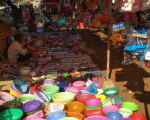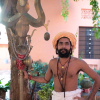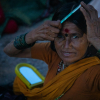This photo essay seeks to elaborate on the celebration of the pooni mela in the year 2019, observed between the 19th of February and 4th of March. Rajim Maghi Punni, also known as Rajim Kumbh, continues to be the fifth Kumbh of India, others being Prayag Raj Kumbh, Haridwar Kumbh, Ujjain Simhastha and Nashik-Trimbakeshwar Simhastha. As is popularly known, kumbh is seen as a sacred site for Hindu pilgrims. The kumbh celebrated in Chhattisgarh-on Magh Purnima holds great significance for both Vaishnavas (devotees of Vishnu) and Shaivites (devotees of Shiva). The reason one observes many devotees of Vishnu and Shiva visiting the ghats on the confluence of the three rivers to worship and offer gratitude to their respective gods during Maghi Punni.
Maghi Punni is celebrated at a time when winter starts fading and spring begins to make its way into Chhattisgarh. The festival is celebrated every year on the day of magh purnima or the full moon night in the month of Magh according to the Hindi lunar calendar. In Chhattisgarh, the festival is of great importance to the non-adivasi communities of Chhattisgarh and, is celebrated on a grand scale. The Rajim Mela is located at the confluence of three rivers Mahanadi, Sondur, and Pairi. Every year a fortnight long celebration is organised, beginning on the day of magh purnima and ends with the celebration of Mahashivratri. On the day of magh punni the worshippers bathe at the juncture where two or more rivers meet; while making offerings to their gods and goddesses. In Dhamtari district of Chhattisgarh, big fairs are organized at four location on the day of the mela, namely at Rudri, Sihawa, Deopur, and Kodoras. However, besides the big fairs, there are several small fairs organized across the district around this time of the year. The gallery presented here largely documents the Rudri Maghi Punni fair.
Magh Purnima is considered as a sacred day among the Hindus- the full moon night in the month of Magh. This month in the Hindi lunar calendar roughly corresponds to the months of February-March in the Gregorian calendar. This is the last day of the month of Magh. According to the Hindu religion, purnima (full moon) is known to be an auspicious day for performing rituals. It is believed that bathing in the river and making offerings to the poor is part of balancing bad karma (sins) with good deeds. Thus, it is celebrated magnificently and carries a special significance. The magh punni celebrations coincides with madais organized across the state in the post-harvest season. Post the celebration of Devari, various villages organise fairs across the state to celebrate madai- a time when people come together to celebrate the good harvest and end of the labouring season with their ancestral deities.
As discussed above the Magh Purnima melas are organised across four villages/towns in particular that have Shiva (Hindu god) temples on the bank of river Mahanadi. Rudri accordingly is situated on the bank of river Mahanadi. It also has a small dam called the Rudri dam that controls water in the channel (from Gangrel dam) to Bhilai Steel plant. The town is located 87 kilometres away from Raipur. It is believed, during the reign of Rudra Dev of Chandra dynasty, Rudri was the erstwhile capital of the kingdom of Kanker. The temple is believed to have belonged to the era of the Chandra dynasty. The Chandravanshi king, Rudra dev is believed to have constructed the shrine of Rudreshwar Mahadev. The temple enshrines a figurine of Lord Shiva who is its presiding deity. The temple being very old was recently reconstructed around ten years ago. It is believed that the Shivalinga originated at the site of the temple and thus, remains very auspicious. It is also houses the idols of Sita, Ram, Laxman, and Hanuman. Outside the Rudreshwar Mahadev temple, one finds several hawkers who sell flowers, sweets and puja samagri for the visitors who come to make offering in the temple. An important part of what is offered to the lord is dhatura (jimson weed), the fruit of Aak tree, coconut and bel patra (bel leaves). Apart from these, few shops also sell chuda/ chiwda (flattened rice) for offerings. On the day of magh punni, devotees begin arriving at Rudreshwar ghat around four in the morning. As part of their ritual they bathe before the break of dawn. After bathing the devotees proceed to worship Rudreshwar Mahadev in the temple. The visitors stand in long lines to worship the lord. The devotees make offerings of dhatura (jimson weed), fruit of Aak tree, coconut, bel patra (bel leaves), genda flower (marigold). People also give rice as offerings to the poor who sit outside the temple.
The mela is annually organised with the help of the district level government on the day of Magh Purnima. The government organizes the process of booking of stalls at the fair, parking spaces as well as security beside the ghat (the river bank). Preparations start a month before the date of the fair. From early morning one can find men, women, and children walking in crowds and enjoying the essence of the festival and fair with their families and friends. As shared above, on one side of the temple there are hawkers selling items to be offered to lord Shiva, while on the other side, there is a big market where people shop for their everyday requirements. The fair also becomes space of economic transaction where purchases are made as part of the preparations for the upcoming marriage season.
Magh Punni is a festival of prominence for the non-adivasi communities in the state of Chhattisgarh. A fair that is a site of coming together- people from different villages gather to perform rituals at the bank of the river and the fair festivities. A festival of the spring where people make new associates and renew their old associations as well.
This content has been created as part of a project commissioned by the Directorate of Culture and archaeology, Government of Chhattisgarh to document the cultural and natural heritage of the state of Chhattisgarh.

















